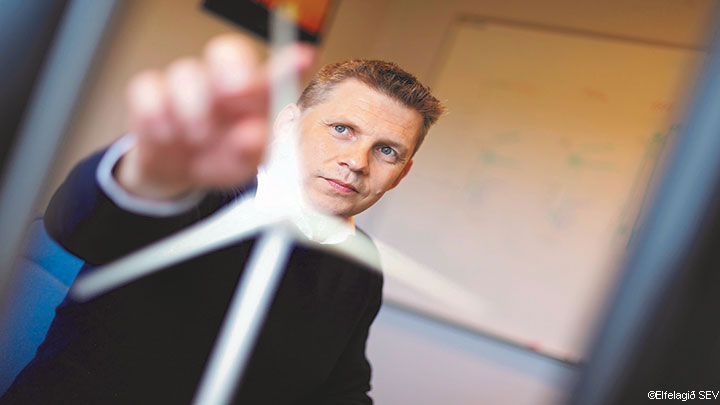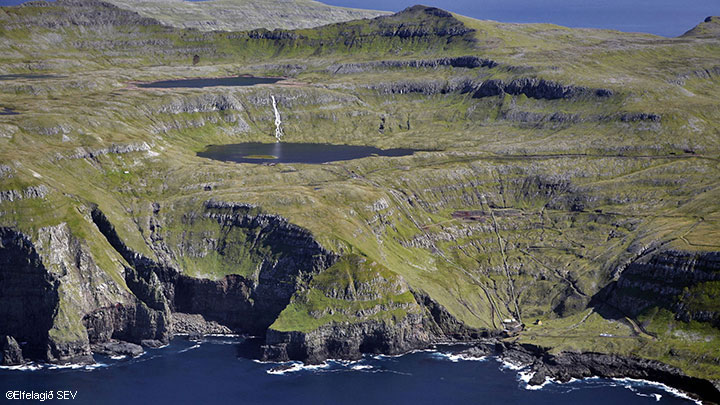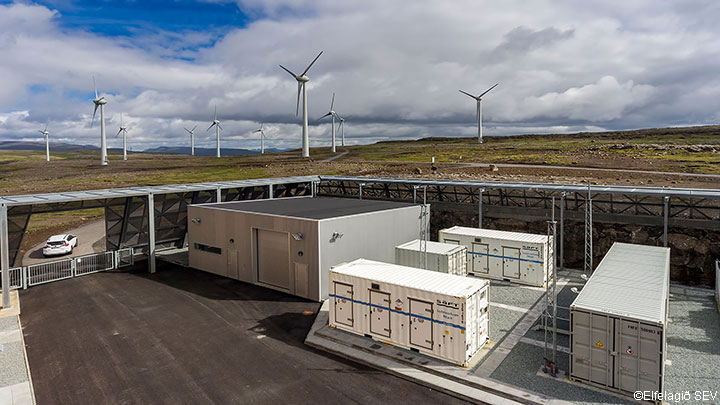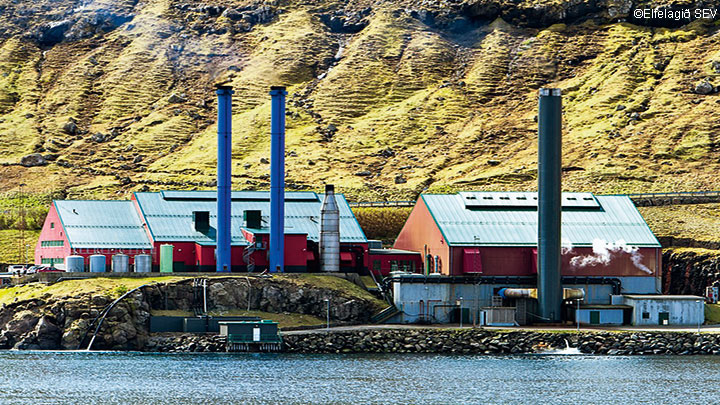The Faroe Islands are aiming for complete sustainable energy supply by creating a smart and innovative micro-grid
Far from continental Europe and surrounded by a vast sea, the Faroe Islands lie in the middle of the North Atlantic between Iceland and Norway. Such a remote location poses many challenges when it comes to energy supply but local provider, Elfelagið SEV, has found a way to harness the natural resources of the islands and ensure a constant electricity supply.
Terji Nielsen stands on a foggy, elevated plateau close to Torshavn, the Faroese capital. A cold and strong wind is beating as he fastens up his jacket and rubs his hands together to fight off the cold. “Well, that’s summer on the Faroes,” he laughs – it’s the beginning of June! There is also pride written on his face as he stands in the middle of a massive wind park where the blades of the turbines swirl in the heavy winds.
Nielsen is Head of R&D at Elfelagið SEV, the publicly-owned, primary power-producer on the islands, and he has a clear vision: “Our future energy supply in the Faroes is green. We have set a goal of becoming 100% green by 2030 in terms of on-shore electricity.”

Terji Nielsen, Head of R&D at Elfelagið SEV
Surrounded by strong winds, rough seas and summers with almost 24 hours of light, conditions seem ideal for generating electricity from renewable sources for the local population of 52,000, spread over 18 scattered islands. “In the Faroe Islands, we are blessed with renewables: we have wind, hydro and some sun in the summer; we also have tidal and wave power where we can see great potential,” says Nielsen.
Since announcing its green vision in 2014, SEV has already done a lot to increase the share of renewables in its energy mix. Today, an average of 50 % of the islands’ energy consumption is already met by green energy. The 13 turbines in the wind park that Terji Nielsen is standing in produce a total of 12MW of power. “Next year already, we will triple our wind generation capacity and then, every other year up to 2030, we will continue installing more wind farms,” says Nielsen. “We will also install PV plants all over the islands on rooftops and larger fields. You see, we have a clear roadmap leading to 2030.”
Another pillar of SEV’s green vision is founded on hydropower with six such plants, delivering a total capacity of 40 MW, having been installed around the islands. In addition, SEV is working on the first pilot projects to harness tidal power. “I think through the intelligent combination of all these renewable resources that it will be possible to become 100% green by 2030,” says Nielsen.

13 wind turbines with a total of 12 MW form the biggest wind park on the Faroe Islands
Can renewables deliver?
There are, of course, numerous challenges along the way: government initiatives are also encouraging islanders to replace oil heating with heat pumps, and petrol or diesel cars with electric vehicles, as a result of which energy demand is set to significantly increase. Even more conservative scenarios predict that the Faroe Islands’ current electricity consumption of approximately 350,000 MWh per year will increase to approximately 450,000 MWh in 2025.
“The current discussion recommends using more green energy and especially the potential for wind energy is quite high,” says one of the islanders. “But what are we going to do when there’s no wind, for example?” He is technical director of a local fishmeal factory which is a big employer on the Faroes. Fishing is, and has been for many decades, the main industry in the Faroe Islands with its products, including farmed salmon, representing more than 95% of total exports, and around 20% of Faroese GDP. “Producing fish meal and oil requires quite a lot of energy. When the fishing season starts, things get very intense and we have to maintain maximum production,” he adds. “If there’s a breakdown, we lose production and never get it back as the supply ships go somewhere else. Therefore, a secure and stable energy supply is essential for our business.”

Next to wind energy hydro power is one of the most important energy sources on the Faroes

SEV has installed a 2.3 MW lithium-ion battery to cope with the fluctuating wind energy
Ensuring a constant supply
Terji Nielsen is also preoccupied with the same thoughts; while the Faroes’ goal is to become more or less fossil-free by 2030, he explains that a secure energy supply remains their highest priority. Therefore, SEV is building a comprehensive and smart backup system to balance the somewhat erratic nature of the renewables. Next to the wind park, SEV has installed a 2.3 MW lithium-ion battery, which was Europe’s first wind-derived storage system when it was set up in 2016. In addition, potential pumped hydro-storage reservoirs are spread all over the islands to provide backup for times with less wind. “The battery provides storage or backup for shorter energy gaps ranging from seconds to minutes, the hydro reservoirs for longer gaps of hours and days, and – finally – in times with less wind and hydro, we still have fossil-fuel generation in place that can provide backup for a much longer time,” explains Nielsen.
In all, SEV operates three thermal power plants, of which the Sund plant is the largest and which is currently being expanded. For this, MAN Energy Solutions has supplied four MAN 9L51/60 gensets fitted with the latest, selective-catalytic-reduction system, significantly reducing levels of NOx and making a crucial contribution to reducing the plant’s environmental impact.
“The role of the Sund power plant has now shifted from baseload into being a smart reliable backup, always available, no matter how`s the weather” says Petri Vehkakoski, Sales Manager for the Faroe Islands at MAN Energy Solutions. “Our engines rapidly step in to supply power when needed and are throttled back when wind or solar conditions improve. This kind of system is able to adapt to the prevailing climatic conditions instantaneously.”
However, Nielsen and SEV also have a green vision for the Sund power plant in mind: “We believe that it is possible for the gensets at Sund to operate on synthetic, carbon-neutral fuel by 2030, meaning that even in years with less wind or hydro, we can still be 100% green.”

The Sund plant is providing valuable back-up to cope with the fluctuating nature of renewables
A positive role model
“The energy system in the Faroe Islands is an impressive example of how all available energy resources can be integrated into a smart and innovative microgrid,” says Vehkakoski. “With climate goals as ambitious as today’s, a sustainable energy supply can only be ensured through the smart combination of renewables, storage and reliable backup systems. In our view, the future is hybrid and the Faroe Islands are definitely a role model for other remote areas all over the world.”
“If other islands have the same ambition as we do, we should definitely learn from each other,” Nielsen adds. “The main challenge for us was to change our mindset. 20 years ago, people told us that we wouldn’t be able to get more than 25% wind energy but we took some risks and, at times, pushed that limit to more than 80%. Now we are one of the front runners in integrating renewable energy into a small island system.”
In 2014 SEV announced its vision to become 100% green by 2030. The reason was two-fold: first of all, we have a lot of expensive fossil-fuel imports to the islands; and, secondly, it’s all about climate change.
For a future-proof world
MAN hybrid power solutions can help you integrate non-dispatchable renewables with energy storage and robust thermal power plants to create sustainable solutions. Such integration of different energy systems allows improved use of your existing power generation resources.
Explore more topics
MAN Energy Solutions is now Everllence.
We have adopted a new brand name and moved to a new domain: www.everllence.com. This page will also be relocated there shortly. We are working on shifting all pages to www.everllence.com.
